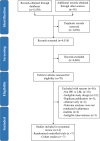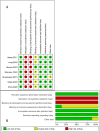Outcomes of interprofessional education for pharmacy students: a systematic review
- PMID: 39563306
- PMCID: PMC11577742
- DOI: 10.1186/s12909-024-06313-1
Outcomes of interprofessional education for pharmacy students: a systematic review
Abstract
Background: Interprofessional education (IPE) refers to a teaching and learning method in which students from two or more professions learn about, from, and with each other to enable effective collaboration and improve health outcomes. A systematic review was performed to investigate the current practice and the effectiveness of IPE in pharmacy education.
Methods: Databases including PubMed, Embase, Cochrane Library, Medline, China National Knowledge Infrastructure, VIP China Science and Technology Journal, and WanFang were searched from inception to September 20, 2024, using search terms such as interprofessional, interdisciplinary, multidisciplinary, IPE, pharmacy, and pharmaceutical education. Studies were screened and included if they were randomized controlled trials (RCTs) or cohort studies reporting the outcome differences between pharmacy students participating in IPE activities and those receiving lecture-based learning. Reporting quality was evaluated using the Cochrane Risk of Bias Assessment Tool 2 and the Newcastle Ottawa Scale. Detailed information including the studies' general information, research methods, and results were collected. Primary outcomes including pharmacy students' interprofessional competence, readiness for and attitudes towards IPE, class satisfaction, and professional knowledge were analyzed with meta-analysis or reported descriptively.
Results: Seven RCTs and seven cohort studies were included in the systematic review. Eight studies reported that IPE demonstrated a positive impact on pharmacy students' interprofessional competence (p < 0.05). Three studies showed that IPE enhanced students' readiness for participating in interprofessional learning (p < 0.05). Four studies revealed that IPE significantly improved the attitude of pharmacy students towards IPE (p < 0.0001). The meta-analysis of the two cohort studies showed that IPE significantly improved the Attitudes Towards Health Care Teams (ATHCT) scale scores (SMD = 0.41, 95% CI = 0.22-0.60). Students who participated in IPE activities were generally satisfied with the course (average score > 4.0 out of 5.0). Apart from embedded in courses, some novel IPE programs were conducted, such as outpatient clinics operated by interprofessional students.
Conclusions: The study revealed that IPE was widely used in pharmacy education. IPE enhanced pharmacy students' interprofessional competence, class satisfaction, and their readiness for and attitudes towards interprofessional learning. The effect of IPE on professional knowledge remained controversial across studies.
Keywords: Healthcare education; IPE; Interprofessional education; Pharmacy education; Systematic review.
© 2024. The Author(s).
Conflict of interest statement
Figures



Similar articles
-
Effects of Interprofessional Education on Readiness for Interprofessional Learning in Rehabilitation Science Students From Professional Health Care Programs: Protocol for a Systematic Review.JMIR Res Protoc. 2024 Nov 20;13:e60830. doi: 10.2196/60830. JMIR Res Protoc. 2024. PMID: 39566907 Free PMC article.
-
Evaluation of an interprofessional education program involving medical and pharmacy students: a mixed-method study.BMC Med Educ. 2025 Jan 11;25(1):48. doi: 10.1186/s12909-024-06574-w. BMC Med Educ. 2025. PMID: 39799314 Free PMC article.
-
A short elective supports the attitudes of medicine and pharmacy students towards interprofessional learning: a pre-post design.BMC Med Educ. 2025 Mar 18;25(1):393. doi: 10.1186/s12909-025-06988-0. BMC Med Educ. 2025. PMID: 40102804 Free PMC article.
-
Attitudes towards Interprofessional education in the medical curriculum: a systematic review of the literature.BMC Med Educ. 2020 Aug 6;20(1):254. doi: 10.1186/s12909-020-02176-4. BMC Med Educ. 2020. PMID: 32762740 Free PMC article.
-
A Systematic Meta-Analysis of the Effect of Interprofessional Education on Health Professions Students' Attitudes.J Dent Educ. 2019 Dec;83(12):1361-1369. doi: 10.21815/JDE.019.147. Epub 2019 Sep 23. J Dent Educ. 2019. PMID: 31548305
Cited by
-
Educational outcomes of emerging teaching methods in undergraduate nursing education: a systematic review and meta-analysis protocol.BMJ Open. 2025 May 21;15(5):e101478. doi: 10.1136/bmjopen-2025-101478. BMJ Open. 2025. PMID: 40398930 Free PMC article.
References
-
- Wu MY, Wu W, Liu SY. The inspiration of cross-specialty medical education and practical ability expansion. Contin Med Educ China. 2016;8(35):22–3.
-
- Wu YP, Yan Q. Discussion and practice on the construction and working mode of clinical pharmacist system. Chin J Clin Pharm. 2014;23(06):337–42.
-
- Liu H, Chai D, Zhu M. How can clinical pharmacists quickly integrate into the medical team. Pract Med Clin. 2019;22(06):644–8.
-
- Quick J. Interprofessional education. J Perioper Pract. 2023;33(11):331. - PubMed
-
- World Health Organization. Framework for action on interprofessional education and collaborative practice. Geneva: World Health Organization; 2010. - PubMed
Publication types
MeSH terms
Grants and funding
LinkOut - more resources
Full Text Sources

